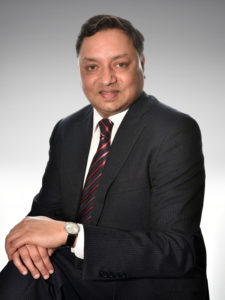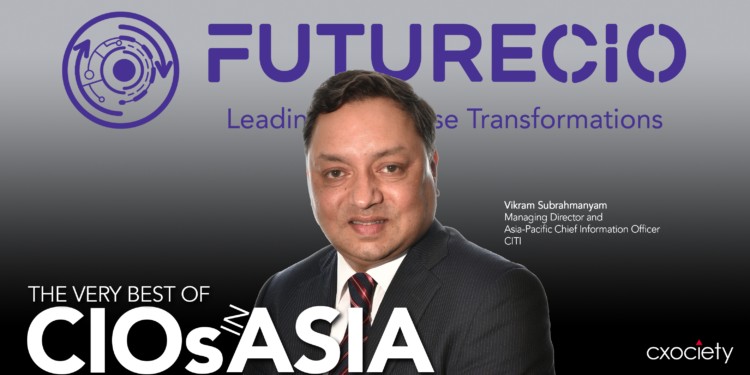Citi, a global bank, covers 16 markets in Asia Pacific, including Australia, Bangladesh, China, Hong Kong, India, Indonesia, Korea, Macau, Malaysia, New Zealand, Philippines, Singapore, Sri Lanka, Taiwan, Thailand and Vietnam.
The region supports 17 million direct consumer clients and several thousand institutional clients in the region, which generates around a quarter of Citi’s earnings and is the bank’s largest regional contributor outside of North America.
Citi’s Institutional Clients Group business in Asia is comprised of Corporate and Investment Banking, Treasury and Trade Solutions, Markets and Securities Services and Citi Private Bank. In addition, it provides consumer banking services in 12 markets in Asia with a focus on building digital capabilities across Cards and Retail Banking, including Wealth Management.
FutureCIO spoke to Vikram Subrahmanyam, Asia-Pacific chief information officer and head of operations & technology for Citi, on the everyday challenges of leading the regional operations and technology requirements of a global bank.
The Citi Operations and Technology (O&T) team in Asia-Pacific

Vikram Subrahmanyam: There are about 32,000 professionals comprising the O&T team in Asia-Pacific. Citi has country-based technology teams complemented by large service centres in Asia. As a global business, the bank also uses third-party service providers including some based in Asia.
Essentially everything; operations, information technology, including data centres, is under my responsibility. As with other global organisations, we leverage several global platforms, some with local presence in Asia, as well as applications that have been built out locally. Applications including those running off mainframes, distributed client/server environments, as well as internal cloud.
Deciding on a career path from within
Vikram Subrahmanyam: I joined Citi in India as a Management Associate, what we call Analysts now. At that time, most did a stint in O&T, including me. Following that, I went on to do different roles including sales, customer service and product management but eventually decided to return back to O&T, which is an area I really enjoy.
My decision to focus my career in O&T was based on 3 key motivations:
- My interest in working with groups of people. I was starting to manage teams then and O&T offered me the opportunity to work closely with many different teams not only within India but across Citi’s global network.
- I had a relatively good understanding of technology and the role it could play in transforming operations; by eliminating manual processes and increasing efficiency, reducing risk and enhancing client experience among others. While I have a degree in information technology, it is about applying technologies into operations rather than merely building out technologies.
- My understanding of operational risk. One thing I learned early on in my career was my ability to proactively address some of the risks inherent in operations as a result of the knowledge I had in this area.
Looking at all of these, I figured a role in O&T would play to my strengths and therefore would allow me to add value to the organisation.
O&T experience – what’s interesting and frustrating
Vikram Subrahmanyam: There are certainly great benefits of having been on both sides of operations and technology; the ability to see the challenges and opportunities from a 360-degree perspective.
Working with technology has allowed me to introduce innovations that change the way we work. When working with operations, it allows me to leverage technology and platforms to speed up workflow processes and deliver tactical benefits to the business.
Together the insights and know-how have enabled me to better anticipate and address any potential obstacles – especially when managing large-scale technology transformation projects both from the user and the business’ perspective. Very often in projects of this scale, there is often a desire to roll out technology, but we don’t spend enough time understanding how we can enhance the process as a result of these new platforms.
On the question of what frustrates me, I see it more as an opportunity. For us in operations, it sometimes seems like technology is moving faster than what we are able to do. On the other hand, wearing my technology hat, I am acutely aware that technologists would like operations to be more agile, for example, like being able to be more precise about what they want.
These O&T desires and expectations are not competing but complementary. Both sides want to achieve what they want to get done – to be able to serve our customers better and deliver value to our product partners.
Independence from global directives
Vikram Subrahmanyam: It is something we think about every day. As a global bank, we must strive for consistency across our technology platforms and operations to the extent possible. We are in 98 countries globally. I like to believe that ‘we think global but act local’ in each market we serve.
Take for example the processing of payments, the standards may be similar across the globe, but when it comes to the last mile, there are local regulatory requirements, reporting standards, local requirements and consumer preferences that you cannot ignore if you want to be relevant to that market.
I don’t think it’s about independence. It is about finding the right balance to leverage the best of the global scale of Citi’s franchise while providing the requisite flexibility at the country-level to execute effectively on initiatives and projects that will deliver the best experiences to our clients.
I don’t think we adopt a global standard without a thorough discussion on the needs of the business. There is an inevitable need for flexibility and customisation at the country or regional level to cater to the needs of the clients.
Proudest achievement
Vikram Subrahmanyam: It would be the successes around our talent programme and the diversity efforts that my team and I have collectively achieved. I am very passionate about gender equality in the workplace. I strongly believe that having a leadership team and an employee base that reflect the same diversity of the communities that we operate in and clients we serve will translate into more engaged employees and result in better business performance.
As a result of targeted initiatives ranging from recruitment, retention to promotion of women, we’ve ensured a fair gender representation in the function which stands at 49% for women across Asia as of last year.
Global programmes like the Prometheus that is all about female talent development, especially in technology. In India, one of our biggest achievement is the launch of Second Careers – a returning women programme.
In Asia, we have an O&T Leadership Development Programme (LDP) where we select a small group of people and allow them to move through accelerated roles in multiple markets.
In 2018, I sponsored the Asia Pacific Diversity Toolkit for Citi. Working with the country and regional talent leads, our objective was to create a one-stop-shop toolkit for comprehensive resources to support the recruitment teams in promoting Citi as an employer-of-choice for women.
The COVID-19 disruption
Vikram Subrahmanyam: Previously, we had our notion that many roles (in the bank) are not amenable to working from home.
These last six months, and in part due to the rapid evolution of technology and improved infrastructure, the majority of such roles can now be done remotely.
The bottom line is that (in some markets) between 80% to 90% of our colleagues now work from home. It varies by market. I think we’ve been able to be very effective during this crisis. Our return to work strategy is focused on the health and safety of our colleagues.
We are not focused on “I must come to the office by such and such date” rather we look at what the data tells us. Using Hong Kong as an example, we’ve been very flexible about the ability to get people into the office but also move rapidly to get our people back to work from home if required based on what the data is showing.
We are evolving, learning and adapting. I’m very proud of the flexibility we’ve delivered here to the franchise in Asia. I've been leading the effort here with our planning, execution and responsiveness throughout the organisation, working collaboratively with teams across the region and leveraging some of our global expertise.
Pandemics have been part of our business continuity plan for over 10 years. Unlike SARS, COVID-19 has created more challenges. But having said that, our recovery plans held up with minimal disruption to our operations and the servicing of clients.
It has shown that we have a lot more resilience and adaptability than we thought possible. We’ve adapted to a new way of communicating, of doing business digitally, and in return, our clients have adapted moving more of their business and interactions with us to digital.
Digital transformation will continue to drive our future. It is important that whatever we’ve learned throughout this pandemic, we hold on to the best of that, and be able to serve our clients.
The biggest challenge in the coming years
Vikram Subrahmanyam: First is cybersecurity. As we move more of financial services digitally, cybersecurity will remain an important aspect of what we plan for. Our clients trust us to protect their assets and data. We will continue to work with our partners globally to ensure that we adopt the best tools to protect ourselves as well as our clients.
Second is change. Change is the new normal. I think of a quote from Bill Gates: “We always overestimate the change that will occur in the next two years, and underestimate the change that will occur in the next 10. Don’t let yourself be lulled into inaction.”
It’s hard to identify when change is going to happen. The scale of change arising from COVID-19 is a great example. But it proves that change can happen at extraordinary speed. We must deal with that to successfully navigate and guide our teams through these uncertainties.
Leaders need to be agile, adaptable, resilient, empathetic, and learn how to fail fast for us to emerge stronger than ever.
This is equally true for operations and technology leaders.
Advice to aspiring CIOs
Vikram Subrahmanyam: Getting as much experience under your belt in the early stages of your career, even outside of the technology space, a good understanding of your business partners’ drivers and needs, a good understanding of motivating people and leading people, a good understanding of how technology can help drive solutions for the organization.
I think having empathy at many different levels, being able to put yourself in your client's shoes, in your employees’ shoes, in your business partners’ shoes – all of these will be things I think will work very well for CIOs going into the future.
It is important to remember that technology will continually expand. We will not be experts at everything. We need to be able to understand who are the people who have the right talent that we can bring on board to be able to help broad-base our approach in supporting our businesses and our functions.
I think that will be very important – identifying the right talent.





